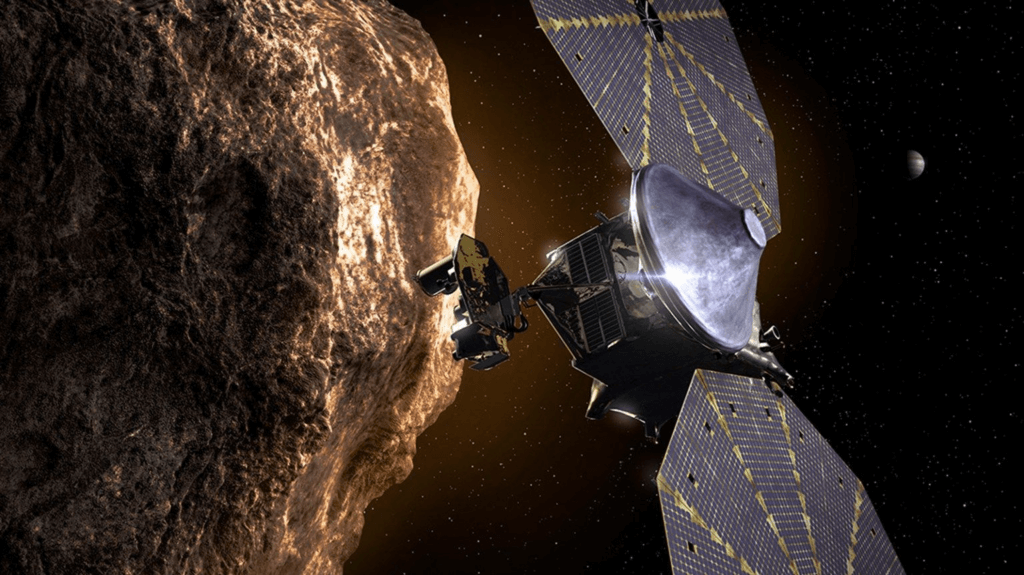Daily Current Affairs : 4-November-2023
NASA, the esteemed space agency, recently achieved a milestone by completing the first flyby of an asteroid named Dinkinesh with its Lucy spacecraft. The Lucy Mission, named after a 3.2 million-year-old ancient fossil, embarks on a remarkable 12-year journey encompassing eight different asteroids. One of these asteroids resides in the Main Belt between Mars and Jupiter, while the remaining seven, known as Trojans, follow unique orbits.
Notably, Lucy stands as NASA’s inaugural single spacecraft mission exploring such a diverse array of asteroids. A notable feat, Lucy operates on solar power even at an astounding distance of 850 million km away from the Sun, making it the farthest-flung solar-powered spacecraft in NASA’s history.

Mission Objectives: Unraveling Cosmic Mysteries
The primary objective of the Lucy Mission is to unravel the mysteries surrounding the formation of our solar system, which dates back a staggering 4.5 billion years. The mission delves into the study of rocky bodies orbiting the Sun in two distinct swarms—one preceding Jupiter and another trailing behind it. This endeavor promises invaluable insights into the origin and evolution of celestial bodies, enhancing our understanding of the cosmos.
Encounter with Donald Johnson Asteroid
Lucy’s inaugural encounter takes place with an asteroid located in the main asteroid belt between Mars and Jupiter, aptly named ‘Donald Johnson’ after the renowned paleoanthropologist who discovered the fossilized remains of “Lucy.” This encounter marks the beginning of Lucy’s extensive exploration of various asteroids, each holding its unique scientific significance.
Understanding Asteroids: Cosmic Marvels
Asteroids, intriguing rocky objects, orbit the Sun, distinct from planets due to their smaller size. They are classified based on their orbits, revealing the fascinating diversity of their trajectories:
- Main Asteroid Belt: Situated between Mars and Jupiter, this region hosts numerous asteroids, serving as a testament to the solar system’s vastness and complexity.
- Trojan Asteroids: These asteroids orbit larger planets in Lagrange points, where the gravitational forces of the sun and the planet achieve equilibrium. Jupiter, Neptune, and Mars boast trojans, showcasing the intricate dance of celestial bodies.
- Near-Earth Asteroids (NEA): NEAs circle closer to Earth than the sun, offering scientists an opportunity to study asteroids’ proximity and potential impact on our planet.
Lagrange Points: Gravitational Balancing Acts
In the cosmic ballet of celestial bodies, Lagrange points play a pivotal role. These points represent locations in space where the gravitational forces of two large masses, such as the Sun and Earth, balance each other. Small masses positioned at these points remain at constant distances relative to the larger celestial bodies. The Sun-Earth system features five Lagrange points denoted as L1, L2, L3, L4, and L5, showcasing the delicate equilibrium in the vastness of space.
Important Points:
- NASA’s Lucy spacecraft completed its first flyby of the asteroid named Dinkinesh, marking a significant achievement in space exploration.
- Lucy Mission is a 12-year journey that aims to explore eight different asteroids, including one in the Main Belt between Mars and Jupiter and seven Trojans, making it NASA’s first single spacecraft mission to study such a diverse range of asteroids.
- The mission is named after a 3.2 million-year-old ancient fossil and seeks to unravel the mysteries of the solar system’s formation 4.5 billion years ago.
- Lucy operates on solar power even at a distance of 850 million km away from the Sun, making it the farthest-flung solar-powered spacecraft in NASA’s history.
- The first encounter of the Lucy spacecraft was with an asteroid in the main belt, named ‘Donald Johnson’ after the paleoanthropologist who discovered the fossilized remains of “Lucy.”
- Asteroids are rocky objects orbiting the Sun, distinct from planets due to their smaller size.
- They are classified based on their orbits, including Main Asteroid Belt between Mars and Jupiter, Trojan asteroids orbiting larger planets in Lagrange points, and Near-Earth Asteroids (NEA) that circle closer to Earth than the sun.
- Lagrange points are specific locations in space where the gravitational forces of two large masses balance each other, creating stable points where other objects can remain at constant distances relative to the larger bodies.
- The study of asteroids and their orbits provides valuable insights into the evolution and dynamics of the solar system, enhancing our understanding of the universe.
- Lucy’s mission signifies a crucial step in humanity’s quest for knowledge, inspiring future generations to explore the vastness of space and unravel the cosmic mysteries that surround us.
Why In News
NASA’s Lucy spacecraft, a testament to human ingenuity and exploration, successfully completed its first flyby of an asteroid named Dinkinesh, providing scientists with valuable data about the asteroid’s composition and structure.
MCQs about Lucy Mission
-
What is the main objective of NASA’s Lucy Mission?
A. Exploring distant galaxies
B. Studying the formation of the solar system
C. Investigating black holes
D. Analyzing Martian surface features
-
Which asteroid was Lucy spacecraft’s first encounter named after?
A. Dinkinesh
B. Donald Johnson
C. Trojans
D. Lagrange Points
-
What distinguishes Trojan asteroids from those in the Main Asteroid Belt?
A. Trojan asteroids orbit Lagrange points
B. Main Belt asteroids are larger in size
C. Trojan asteroids are closer to the Sun
D. Main Belt asteroids have unique surface features
-
What is the significance of Near-Earth Asteroids (NEA) in space exploration?
A. Source of extraterrestrial life
B. Potential impact on Earth
C. Suitable locations for human colonization
D. Study of distant galaxies
Boost up your confidence by appearing our Weekly Current Affairs Multiple Choice Questions
![]()


